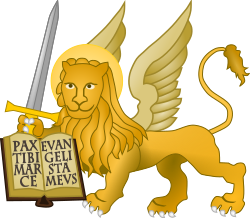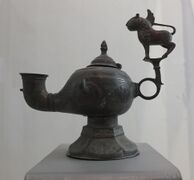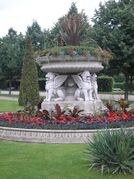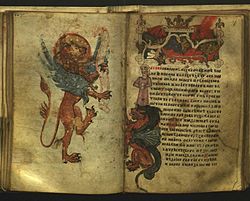Unsolved:Winged lion
From HandWiki
Short description: Mythological creature
The winged lion is a mythological creature that resembles a lion with bird-like wings.
Mythical adaptations
The winged lion is found in various forms especially in ancient and medieval civilizations.
There were different mythological adaptions for the winged lion:
- Lamassu or shedu in Mesopotamian mythology was depicted as a winged lion. It was often depicted with a bull's body instead of a lion's body.
- The griffin in classical mythology was depicted as a lion-eagle creature. Griffin-like creatures were depicted in Egyptian and Persian mythology.
- The first beast in the first vision of the biblical prophet Daniel resembled a winged lion.
- The winged lion was the heraldic symbol of Mark the Evangelist.
- The Goetic demon Vapula was depicted as a winged lion.
Emblems
The emblems of the winged lions were featured in different countries:
- The emblem of the Republic of Venice as the heraldic symbol of St. Mark the Evangelist, the patron saint of the Republic.
- The Lion of Venice is an ancient bronze sculpture of a winged lion that is located in the Piazzetta di San Marco, Venice
- The flag of the short-lived Septinsular Republic, derived from the above (Ionian Islands under Venetian rule), has a winged lion on it
- The logo of the Italian company Assicurazioni Generali which has a winged lion on it was derived from the above
- The emblem of the North Atlantic Treaty Organization (NATO) Allied Joint Force Command Naples headquarters, in Italy, is a winged lion holding a sword and scroll on which is written PAX - Latin for 'peace'.[1]
Gallery
12th-century oil lamp from Khorasan
See also
- Aq Bars
- Chimera
- Griffin
- Lamassu
- Manticore
- Merlion
- Nemean lion
- Sea-lion
- Sphinx
- Winged cat
- Lion depictions in art
References
External links
 |











